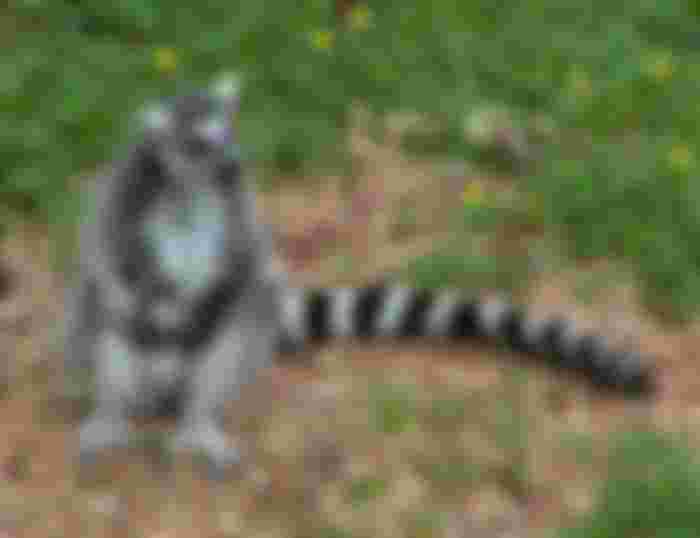Experts estimate that tropical storms and droughts will increase in Madagascar in the coming years. For narrowly specialized primates, this means an emergency call.
Sandy beaches, lush rainforests, exotic plants and animals - are epithets that attract hundreds of thousands of tourists every year to an unusual island in the Indian Ocean. Due to its long history of origin and unique diversity in relief and living world, Madagascar is said to be a country that time has forgotten.

Thanks to the fact that over 80 percent of the fauna of this fourth largest island on the planet is endemic (ie species that only find their home there and nowhere else), many ecologists speak of Madagascar as the eighth continent. This is not so strange considering that the island began to separate from Africa after the extinction of the dinosaurs and that many of the plants that live there today are relics or descendants of ancient species found at the time of separation. That is why the preservation of animal species from this island is especially important.
Although from the previous descriptions it seems as if Madagascar is a tropical paradise of untouched nature and hospitable climate, this is not always the case, and its perhaps most famous inhabitants - lemurs - can especially testify to that.

These lovely mammals, numbering over 100 species, live only in Madagascar and some neighboring islands. Although they have long adapted to life on most of the island, many of the species mentioned today are endangered and threatened with extinction.
Leading endangering factors, such as hunting and destruction of their natural habitat (deforestation due to plantation expansion) are not the only threat to their survival. Climate change has imposed itself as another pressure. The example of affected cubs of a species of lemur that are in danger of not getting enough milk from their mothers, gives us an insight into how much the living systems are actually interconnected and in delicate balance with external influences.
Specific climate conditions
Lemurs are accustomed to two climatic seasons in their habitats - the warmer, rainy season from November to April and the colder, dry season from May to October. However, since Madagascar is characterized by an exceptional diversity of habitats, each of them has a different microclimate. Deviations from the existing rules are the cause of the negative impact of climate on endemic lemurs.
Madagascar is often hit by trade winds and periodic cyclones. Its east coast is especially sensitive to the El Niño phenomenon, ie. ocean-atmospheric oscillations which are manifested here by periodic cycles of drought and extreme precipitation. For rainforests on the east and southeast coast of Madagascar, this unpredictable dry period is critical, when the amount of precipitation is drastically reduced.

Heroes from canvas dissapper in real world
In one species of lemur from the rainforest, Edwards' sifaka, during El Niño years, an increased mortality of cubs and a reduced rate of fecundity (reproductive ability) were recorded. Studies done on the population of this endangered species have shown that infants of older females are most affected. During droughts, such breastfeeding females feed on hard leaves that are drier and less nutritious, and due to worn teeth, they are not able to chew enough leaves for uninterrupted lactation. Because of that, their cubs are much weaker and more susceptible to diseases and become easy prey for predators.
The effects of cyclones on lemur eating disorders are also not negligible. The lemur collar records a significant loss of weight and reproduction rate, due to the great storm damage inflicted on fruit-bearing trees whose fruits are the primary food source of this species.

Even the usual arid areas of Madagascar have not been spared, as is the case with spinach forests. They are one of the natural habitats of the ring-tailed lemur, popularly known as King Julian XIII. And while the hero of the animated series Penguins from Madagascar seems to have no problem with the heat, his real-life counterpart is tormented by prolonged drought. Some populations of this species have experienced a large decline in numbers due to the increased intensity and frequency of the dry period in their environment. If this situation continues in the future, lemurs will probably have less chance to recover in time.
Uncertain future
Experts estimate that tropical storms and droughts will increase in Madagascar in the coming years. For narrowly specialized primates, this means an emergency call. It is believed that in the next sixty years, due to climate change, as many as two species of weasels and one species of dwarf lemur will lose their habitats. Species that are geographically limited to a very small area are always under the greatest threat of extinction because they are closely adapted and have nowhere else to go. However, scientists believe that not all lemurs will react to changes in the same way. Models of their research have shown that there is a chance that certain species of lemurs will find ecological corridors through which they can inhabit and conquer new spaces. But that, of course, depends primarily on how they cope with other, anthropogenic influences that threaten their survival. It is quite certain that global warming will also affect the population of Madagascar, which will also have to adapt to the new changes. The people will have to look for their lands and plots for cultivating the land in new places. This will inevitably lead to the deprivation of habitat of other species, such as lemurs, because the current unsustainable practices of the local population do not inspire hope that this time people will opt for coexistence with the flora and fauna of Madagascar, thanks to which they have survived on this unique island.

After this really worried words about famous cartoon character on canvas.. We can remind how fun king Julien is (don't forget to move it...👍😁😜):





Is it true or do I think I read that lemurs go to cities and do harm.